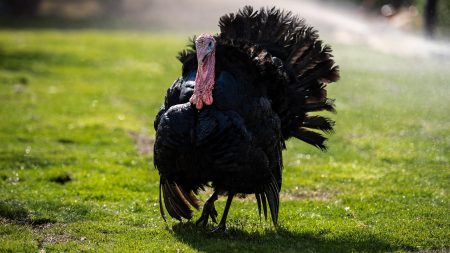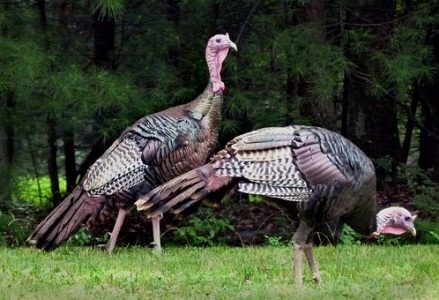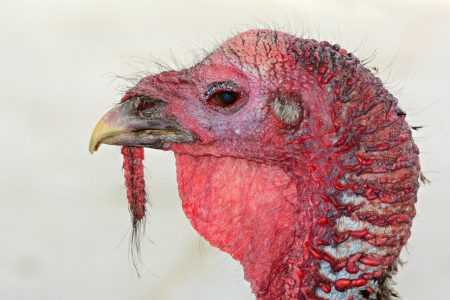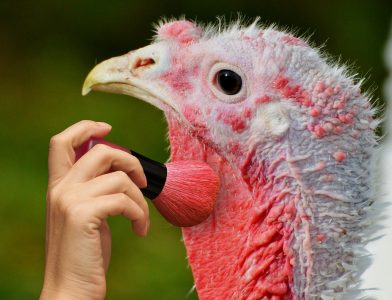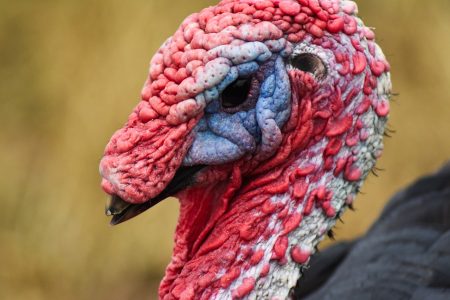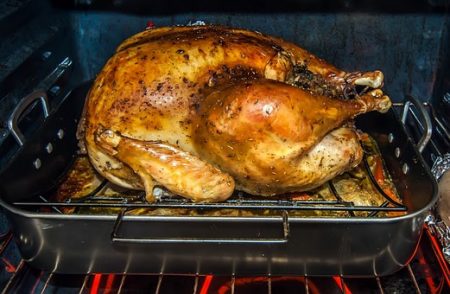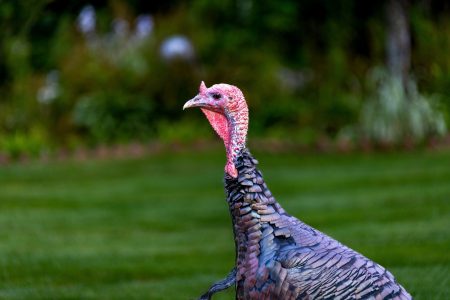- Say thank you to the weird and wonderful turkey on this day.
Happy Thanksgiving from Oddee, everybody! Whether you’ve already enjoyed your dinner or your bird is still in the oven, turkeys are a mainstay at American tables on this day.
But despite its integral role in modern Thanksgiving celebrations, too few people know all that much about this bird. Considering that 46 million of them sacrifice their lives for us each Thanksgiving, it’s only respectable that we get to know turkeys a little better.
Without further ado, here are 9 facts about turkeys that you may not have known about. And if you did, feel free to wow everybody with your turkey knowledge at the dinner table.
1) Turkeys Can Purr
When you think of the sound a turkey makes, your mind probably goes to the gobble. But it’s actually only male birds that make that noise.
The females, on the other hand, make a wide variety of other sounds. They can cluck like a chicken, they can yelp when surprised, and make an unholy screech when scared.
And they can even purr. It’s not exactly like a cat’s purr, but the sound is quite similar and signifies the same thing — a purring turkey is a happy turkey.
2) You Can Tell a Turkey’s Sex by Its Poop
You can tell whether a turkey is a tom or hen without making it purr, though. All you need to do is look at its poop.
Male and female turkeys have differently shaped poop for some reason. If the droppings look like the letter J, they came from a male; if they form a complete spiral, it’s female poop.
You can even approximate the bird’s age from its poop. The thicker the crap, the older the turkey.
3) Turkeys Have Incredible Eyesight
It might surprise but turkeys have excellent vision. In fact, their eyesight is among the best in the entire animal kingdom.
Of course, comparing eyesight is always at least moderately open to interpretation. But biologists broadly agree that turkeys have three times more accurate vision than humans.
Not only that, they can see color and their vision covers 270 degrees. That’s why sneaking up on one of these birds is so difficult.
4) Turkeys Change Color Like Chameleons
Another bizarre superpower turkeys have is changing their color like chameleons. No, they won’t blend into their surroundings and neither do chameleons — instead, like with the reptiles, the color change tells you about the bird’s mood.
The coloring of a turkey’s head can change from white to red and even blue, depending on how it feels. And the brighter the color, the more intense emotional turmoil the turkey is experiencing.
5) Benjamin Franklin Preferred Turkeys to Bald Eagles
The bald eagle is the symbol of America, but if you asked Benjamin Franklin, we probably should revere the turkey instead. Franklin had a great deal of respect for turkeys and thought they were more virtuous than eagles.
He described the bald eagle as a “bird of bad moral character” due to its tendency to steal from other birds. The turkey, meanwhile, was a “respectable … bird of courage” and a “true original native of America” in his view.
He never advocated for the turkey to become America’s national bird. But he probably wouldn’t have been opposed to the idea.
6) Turkeys Are the Birds Most Closely Related to Dinosaurs
We know today that birds evolved from feathered dinosaurs. And out of all the birds out there, turkeys — and chickens — are the ones most closely related to their monstrous ancestors.
A 2014 study found that the chicken lineage, including turkeys, has experienced the least chromosomal change since the days of the dinosaurs. That means the turkey in your oven is probably the closest thing you’ll ever see to a real dinosaur.
7) Turkeys Can Be Complete Psychos
Should you come from an area with a lot of turkeys, their close relation to dinosaurs may not surprise you. After all, turkeys can be horrendously violent, feral monsters.
Especially during mating season, male turkeys get so hopped up on hormones and testosterone that they’re ready to fight anything and everything. But it doesn’t need to be mating season — sometimes, turkeys just decide to become feathery balls of fury for no apparent reason.
For example, a psychotic turkey terrorized a California park for months in 2020, while this year, another crazed gobbler went on a rampage in Washington, D.C.
8) Europeans Loved Eating Turkey Long Before Thanksgiving
Turkeys are intrinsically linked with Thanksgiving. But Americans don’t have an exclusive right to enjoy these birds for a meal.
In fact, they were popular fare in Europe long before the first Thanksgiving in 1621. By 1511, Spanish King Ferdinand ordered all ships traveling to the New World to bring back five male and five female turkeys. Meanwhile, the first recorded turkey farm in Europe dates to 1530.
Of course, Native Americans had already been eating turkeys for millennia at that point. We’re just saying that eating turkey may not have been exactly a new experience for the Pilgrims on that first Thanksgiving.
9) Turkeys Survived Extinction… Twice
Although they aren’t endangered now, we’ve come very close to losing turkeys to extinction. And it’s happened twice.
The first near-extinction happened some 10,000 years ago when the California turkey disappeared. Fortunately, the wild turkey managed to fill its niche.
The second time turkeys faced extinction came in the early 1800s. Settlers overhunted the birds to the point that they had disappeared from Connecticut by 1813, Vermont by 1842, and by 1930, they were nearly gone altogether.
It took a decades-long relocation and conservation effort to save the turkey. But the project was successful and today, the wild turkey population has bounced back almost to what it was originally.
Hits: 0

